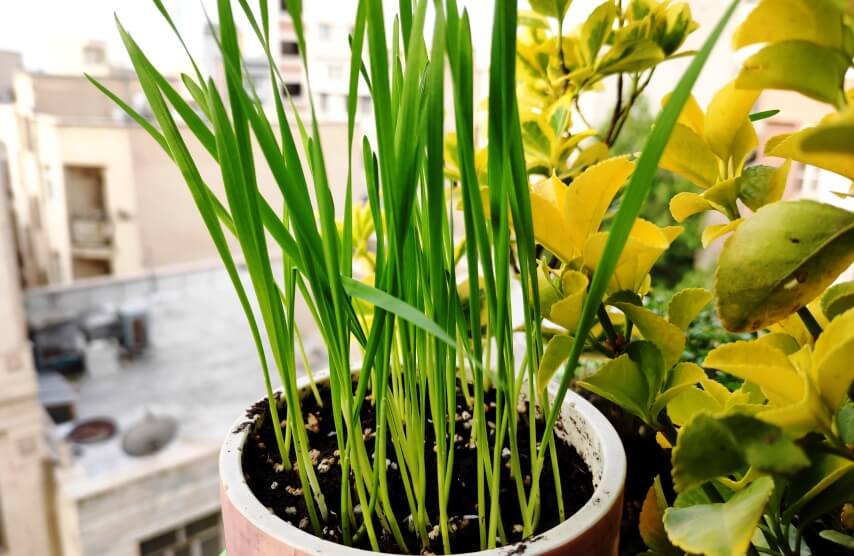Wheatgrass is the common wheat plant’s earliest young leaves. While being a wheat product, Wheatgrass microgreens do not contain gluten and are acceptable to eat if you follow a gluten-free diet. Wheatgrass microgreen is very nutritious. It is even healthier than ordinary vegetables. But remember that you should not overeat wheatgrass microgreens. You can consume them one hour after a meal to avoid headaches and nausea.
Wheatgrass consumption method differs from most microgreens like: micro basil, micro radish, micro alfalfa or corn microgreen. It is usually dissolved in a juicing machine and consumed as a beverage rather than eaten raw. It has a lovely green flavor. Some wheatgrass lovers mix it with bananas and other fruits to make the juice even more delicious and nutritious.
If Like to know more about microgreens, check these articles:
<<What Are Microgreens >> and <<Top 5 Types Of Microgreens>>
wheatgrass microgreens overview
| Family | Poaceae |
| Nutrition | Vitamin A, B, C ,E, Calcium, Phosphorous, Potassium, Manganese |
| Average days to germinate | 2 to 3 days |
| Average days to harvest (after germination) | 8 to 10 days |
| Difficulty | Easy |
Why consuming wheatgrass microgreens?
According to studies, one-eighth of a cup of wheatgrass juice contains the same nutrients as two pounds of leafy green vegetables. Wheatgrass offers twice the amount of vitamin C as orange juice and has twice as much vitamin A as carrots.
Wheatgrass microgreens contain complex vitamins a, c, e, k, and b, iron, magnesium, calcium, enzymes, phytonutrients, selenium, chlorophyll, cultivars, and 17 amino acids, the combination of which has many health benefits.
How to make wheatgrass juice
What are the health benefits of wheatgrass microgreens?
Wheatgrass has several benefits for our bodies. Some of these benefits are as below:
Eliminating toxins
Wheatgrass improves liver function and helps the body’s detoxification process.
Helping Digestion
The enzymes in wheatgrass microgreens help the foods break down and absorption of nutrients.
Increasing metabolism
Wheatgrass is a dense, low-fat, low-calorie, nutritious food. That is why it is suitable for diets.
Reducing Cholesterol
Wheatgrass lower cholesterol, resulting in a decrease of heart diseases.
Boosting the Immune System
It can boost the immune system.
Lowering blood pressure
chlorophyll is similar to hemoglobin and normalizes blood pressure. So consuming wheatgrass microgreen can improve blood circulation and help purify the blood.
Improving Cognitive Function
Wheatgrass improves mental function and assists with Alzheimer’s disease. It can increase hand-eye coordination and help prevent memory loss.
How to Grow Wheatgrass Microgreens
You can easily grow wheatgrass microgreens in your kitchen or out of the garden. All you need is light, seeds, pot or tray, soil, and water.
Wheatgrass is simple to grow, although it takes longer to attain the growth volume necessary to harvest the grain for juicing. The seeds are relatively large, so it is critical to soak wheatgrass seeds overnight before using them. The pre-soaking will ensure a consistent germination and growth rate.
It is impossible to overstate the importance of growing wheatgrass microgreens in organic, nutrient-rich soil and supplementing with organic nutrients after germination. Wheatgrass juice’s healthiness is derived directly from the beneficial characteristics of the soil in which it is cultivated. So, choose nutritious, sterile soil for this purpose.
wheatgrass microgreen seeds
Growing steps of wheatgrass
First, you should wash the wheatgrass microgreens seeds and then put them in a container full of water. Soak them for about 8-12 hours, and then rinse again.
Second, pour your soil into the tray and soak it thoroughly.
Third, sow the seed on the soil evenly.
Fourth, water your seeds twice a day for two to three days and keep them in a warm place. During this period, the seeds germinate and grow and turn into grass. When the wheatgrass has reached about 1-2 inches, it is time to place it where it can receive sunlight. To prevent mold from wheatgrass, use good quality seeds and provide them with controlled air and humidity.
Finally, when grown to 4-6 inches tall, you can harvest them with a sharp knife or scissors. It usually takes 10 to 14 days for this to happen.
Place the entire tray in the refrigerator to hold it to size if the grass is at the harvest stage, but you are not ready to cut it. Wheatgrass microgreens can be refrigerated for up to a week after being liquefied without losing their nutritional content.
Is Wheatgrass microgreens Effective in Treating Your Illnesses?
Wheatgrass lovers use it to try and combat some everyday health conditions, including colds, coughs, fevers, digestive problems, and skin conditions. Wheatgrass microgreens also have been used to potentially prevent and treat more severe conditions, from cancer to AIDS.
Conclusion
Wheatgrass microgreens are one of the healthiest microgreens on the market. They are simple to grow and may be done in any home. Unlike other microgreens, they are rarely consumed uncooked. People extract juice from them and consume it as a microgreen juice or smoothie. They are nutrient-dense, containing vitamins a, c, e, k, and b, as well as iron, magnesium, calcium, enzymes, phytonutrients, selenium, chlorophyll, cultivars, and amino acids. Colds, fevers, stomach disorders, and coughs are among the illnesses that wheatgrass microgreens can help prevent.
If you have ever grown wheatgrass microgreens or would like to try it out, please share your experiences and views in the comments section below.
If you interested in growing wheatgrass microgreens, you can purchase them from Amazon web site.









